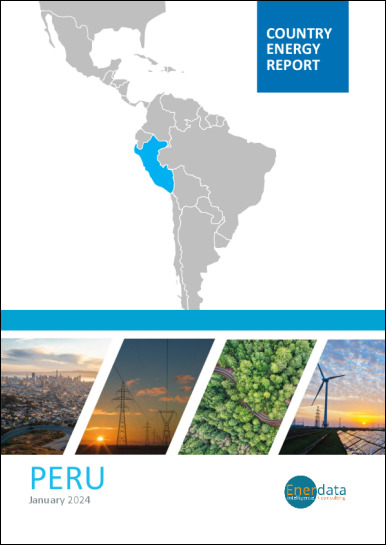- Update
-
- Format
- 3 files (PDF report, 2 Excel files)
- Pages
-
31 (Report only)
- Delivery
- Immediate by e-mail
- GENERAL OVERVIEW
- INSTITUTIONS AND ENERGY POLICY
- ENERGY COMPANIES
- ENERGY SUPPLY
- ENERGY PRICES
- ENERGY CONSUMPTION
- ISSUES AND PROSPECTS
- DATA TABLES
- ABBREVIATIONS
- GLOSSARY
Buy Peru energy report
Price without VAT. Depending on your statute and location, VAT might be applicable. Get in touch with us for more information.
After validation, you will immediately receive 3 files by email (one pdf report and 2 excel files containing the datasets).
Overview
This analysis includes a comprehensive Peru energy market report and updated datasets. It is derived from the most recent key economic indicators, supply and demand factors, oil and gas pricing trends and major energy issues and developments surrounding the energy industry. The report provides a complete picture of the country situation, dynamics, current issues and future prospects. With market data and continuous follow-up of markets news, this report brings clear and concise insights with which to tackle national energy challenges and opportunities. Browse the tabs below for a detailed table of contents, the list of graphs and tables, and details on the data files.
Highlights
- Renewables are planned to account for 60% of the electricity mix in 2025 and GHG emissions should be reduced by 30% in 2030 compared to a BAU scenario.
- Kallpa, Engie, Enel, and Electroperu are the main electricity producers, with 55% of the total electricity generation.
- Pluspetrol represents over 80% of total gas production.
- The power mix is dominated by hydroelectricity, with a fluctuating share, depending on hydro availability (53% on average over the last 5 years), followed by natural gas (40%).
- Gas production has grown by 7%/year since 2020.
- Motor fuel prices are among the highest in South America.
- Electricity prices are quite stable and in line with the regional average.
- Total energy consumption increased by 7% in 2023.
- Oil and gas cover 73% of this energy consumption.
- Peru has around 4 GW of solar and wind projects under development.
Institutions & Energy Policy
The Ministry of Energy and Mines (MINEM) is in charge of the energy sector, through three main Directorates: the General Directorate of Hydrocarbons (DGH), the General Directorate of Electricity (DGE), and the General Directorate of Mines (DGM).
Energy Companies
Electricity:
Kallpa is the largest power generator, with a production of 11.4 TWh (18% of total) and a capacity of 1.7 GW in 2023.
Engie had a production of 8.8 TWh in 2023 (14% of total), with a capacity of 1.1 GW.
Energy Supply
Oil:
Oil production has remained stable since 2021 (4.4 Mt in 2023), after a decrease of 26% in 2020. It grew by 4%/year between 2017 and 2019, after another drop of almost 30% between 2014 and 2016.
Energy Prices
Oil:
Oil products are subject to the IGV (General Tax on Sales) of 18%, and to the ISC (Selective Tax on Consumption) which varies according to the nature of the fuel. In 2018, the ISC was established around PENc25-28/l (US$c7.5-8.4/l) for gasoline and PENc33-37/l (US$c10-11/l) for diesel, thus accounting for around 10% and 7% of the prices, respectively.
Energy Consumption
In 2023, energy consumption per capita was 0.75 toe, which is around 45% below the Latin American average. Electricity consumption per capita was 1 500 kWh.
Issues & Prospects
Gas:
Natural gas is expected to participate in industrial development, while respecting environmental issues such as low carbon energy.
- GRAPH 1: CO2-energy Emissions (MtCO2)
- GRAPH 2: Installed electric capacity by source (2023, %)
- GRAPH 3: Gross power production by source (TWh)
- GRAPH 4: Power generation by source (2023, %)
- GRAPH 5: Gasoline & diesel prices (US$/l)
- GRAPH 6: Electricity prices for industry and households (US$c/kWh)
- GRAPH 7: Consumption trends by energy source (Mtoe)
- GRAPH 8: Total consumption market share by energy (2023, %)
- GRAPH 9: Final consumption market share by sector (2023, %)
- Economic Indicators: Annual historical data including population, GDP growth, imports and exports, inflation rate, energy security and efficiency indicators, CO2 emissions.
- Supply Indicators: Historical data including oil and gas reserves, electric and refining capacity, energy production, power production and external trade. All are detailed by energy source.
- Demand Indicators: Historical data including consumption per inhabitant, consumption trends, total consumption by energy source, final consumption by energy source and sector, and electricity consumption by sector.
- Energy Balances: Single table displaying the overall energy industry balance per annum, also graphically displayed by energy sub-segment.
- Infrastructure Projects: Covers power plant projects by energy, technology, status and operator.
The Peru energy market data since 1990 and up to
is included in the Excel file accompanying the Peru country report.
It showcases the historical evolution, allowing users to easily work with the data.
Key Data included in the excelsheet:
- Economic indicators: Annual historical economic indicators, energy security, energy efficiency and CO2 emissions.
- Supply indicators: Annual historical reserves, capacity, production and external trade (imports(+) exports(-) balance).
- Demand indicators: Annual historical consumption per capita, consumption trends, total consumption, final consumption (per energy and per sector) and electricity consumption total and per sector.
- Energy Balance: total and per energy.
- Peru Energy Prices: In addition to the analysis provided on the report we also provided a data set which includes historical details on the Peru energy prices for the follow items: price of premium gasoline (taxes incl.), price of diesel (taxes incl.), price of electricity in industry (taxes incl.), price of electricity for households (taxes incl.), price of natural gas in industry (taxes incl.), prices of natural gas for households (taxes incl.), spot price of Brent and CO2 emissions (from fuel combustion).
 Energy and Climate Databases
Energy and Climate Databases Market Analysis
Market Analysis